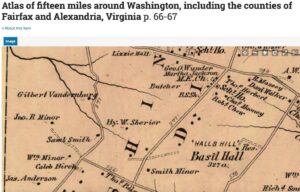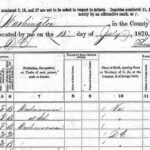
When William died in 1859, his will stipulated that Samuel and his brother Joseph be freed:
In token of my appreciation of the extreme faithfulness with which each of my slaves viz: Joe Smith and Sam Smith have served me, I will that they shall each be free from servitude at the end of the year in which the death of my wife shall occur. That one acre of my Springfield Farm shall be [?] off, for the use of each, around the cabins they now respectively occupy and that they be allowed to enjoy the use thereof so long as the law will permit.
Samuel’s farm lay near the present-day intersection of Harrison Street and Little Falls Road. Samuel does not appear on the 1860 census, either free or enslaved, but he is listed in an 1867 roll of colored voters in the county.
In 1875, Samuel gave testimony to the Southern Claims Court in the case of Catherine Minor, William’s wife. The court compensated citizens for items that Union troops had used, stolen, or destroyed during the Civil War. To receive compensation, applicants had to prove both that they were pro-Union and that the property damage had been carried out by Union soldiers. For the Minor case, a stenographer transcribed, seemingly word for word, the somewhat lengthy interview with Samuel Smith.
The interview reveals that Samuel spent part or all of the war in Washington and that he himself had brought a successful claim before the court. He testified to his proximity to the Minors’ farm, to the damage wrought by Union soldiers, and to William Minor’s Union sympathies:
Q. What do you know about Mr. Minor’s loyalty?
A. Well, I have always heard him say that he would go for the Union and that if the Union was split that we would be gone up.
Five years later, the 1880 Census gives us a picture of who was living on Samuel’s farm: Samuel (age 54), his wife, Annie (age 37), his daughter Elizabeth (age 20), his son John S. (age 14), his daughter Martha (age 6), and his granddaughter Mary (age 10).
After 1880 the trail of records and documents mentioning Samuel Smith disappears, though at least some of his descendants remained in the county for several decades. The 1890 Census was destroyed by fire, but the 1900 Census shows his son, John S. Smith, still living in Alexandria County (now Arlington County) with his family of five children, including an eight-year-old son named Samuel.
—Heidi Fritschel


